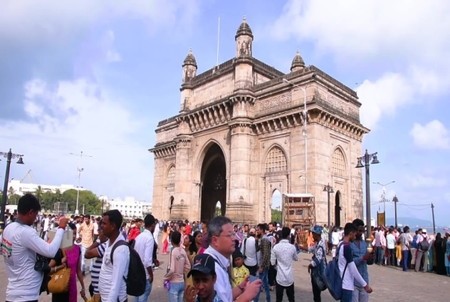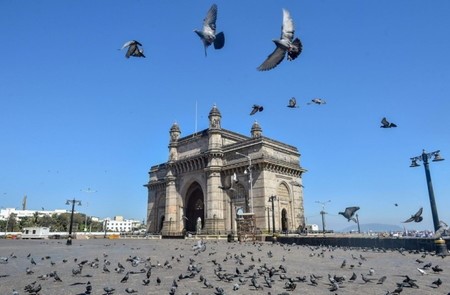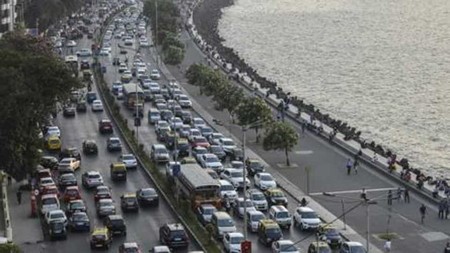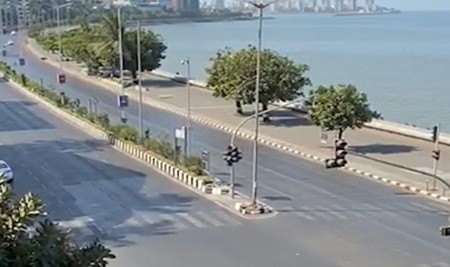【20-34】インドのCOVID-19パンデミックの状況
2020年6月22日 Dr. Vitthal Dhaygude(Krantisinh Nana Patil College of Veterinary Science, Maharashtra Animal and Fishery Sciences University、さくらサイエンスプラン同窓生)
科学技術振興機構(JST)中国総合研究・さくらサイエンスセンター(CRSC)では、2014年度より日本・アジア青少年サイエンス交流事業「さくらサイエンスプラン(SSP)」を実施し、科学技術交流を通じてわが国とアジアを中心とした各国・地域との連携・協力関係を深めてまいりました。各種報道の通り、現在、世界中で新型コロナウイルス感染症の流行が拡大しておりますが、本コーナーでは「さくらサイエンスプラン」に参加している各国・地域の関係機関・関係者より現地の新型コロナウイルス感染症について、その状況や対策等をリポートします。
2019~20年のコロナウイルスのパンデミックの最初の症例は、中国を起源とするもので2020年1月30日に報告されました。 2020年5月19日時点で、インドの保健・家族福祉省は全国で合計101,139人の感染者、そのうち39,173人が回復、3,163人の死亡を確認しています。また、現在の重症患者は58,802人です。(mohfw.gov.in/)
ほとんどの感染者はマハラシュトラ州(州都ムンバイ)で報告されており、それにグジャラート州、デリー市(国の管轄地)、マディヤプラデーシュ州、ラジャスタン州、ウッタルプラデーシュ州、タミルナドゥ州、そしてその他の州の順となっています。
COVID-19に対するインド政府の対応は先制的、積極的、そして段階的なものになっています。政府は当初から公衆の健康危機対応の一環として、スクリーニング、検疫、また監視に関する包括的で強固なシステムを導入するために迅速な行動をとりました。また、政府は感染防止のためのガイドラインを策定し、市民の間で広まっています。

普段の様子:ムンバイにある観光名所「インド門」での混雑

ロックダウン下の様子:閑散とした「インド門」
インドは1月21日に中国から到着する乗客の体温検査を開始しました。2月に入り、同検査はタイ、シンガポール、香港、日本、韓国からの乗客にも拡大され、2月末には、ネパール、ベトナム、インドネシア、マレーシアが追加されました。
3月17日にインド政府は、3月31日までに実行する予防戦略として、社会的距離を確保する措置を講ずることを全ての州に要請する勧告書を発表しました。3月22日に、インド政府は感染の確認が報告されている22の州と国の管轄地の82地区を3月31日までに完全にロックダウンすることを決定しました。さらに政府は3月24日に21日間の完全な国全域にわたるロックダウンを発表しましたが、それは5月3日まで延長されました。(第二期ロックダウン)続いて政府は5月3日~5月17日までの第三期ロックダウンを発表し、そして現在は5月30日までの第四期ロックダウンが実行されています。
学校、大学、オフィス、労働場所、市場、ショッピングモール、公共エリアなどは閉鎖されています。全てのスポーツイベント、集会、会議などは中止となりました。バス、電車、航空便など全ての輸送手段は、ロックダウン中は完全停止となりましたが、政府は、社会的距離を確保するためのガイドラインに反している人々に対しては法的措置をとっています。この期間中でも、重要で緊急なサービスだけは継続されています。

普段の様子:ムンバイの海岸道路の混雑

ロックダウン下の様子:車の通っていない海岸道路
一方、第二期ロックダウンの後、全ての感染者数と新規感染者数について、主要都市の地区と全体の地区をレッド、グリーン、オレンジに色分けして指定しています。色分けの基準は詳細に明記されており、グリーンゾーンでは患者が少ないかゼロ人の状況のため、ある程度の活動は許されています。
貧困者のためには1,700億ルピー(約2,500億円)の救済パッケージが割り当てられており、政府が適切と判断した場合に支出されます。また、政府によって、全ての必要とされる施設を支援し、市民に提供するための計画が立ち上げられました。さらに、ロックダウン中は、州政府も市民に対してあらゆる支援を提供しています。
同時にインド政府は、このパンデミックの拡大を押さえるために検査・監視、検疫や治療のための施設を強化しています。
私たちの大学において、病院と家畜農場での活動は最小限の職員で続けています。学生は自宅にいて、ほとんどの学部は在宅勤務となっています。この期間は、学生のためにビデオ会議のアプリを利用したオンライン講義が行われています。学部では、学生のメンタルヘルスを維持するためにソーシャルメディアを通して定期的に学生と連絡をとるようにしています。
経済的損失については、ほとんど全ての分野が悪影響を受けていますが、正確な金額は未だ算出できていません。
※本稿はさくらサイエンスプラン同窓生からの寄稿文を中国総合研究・さくらサイエンスセンターが日本語訳したものである。
●英文オリジナル
Report on Situation of COVID-19 Pandemic in India
Vitthal Dhaygude
KNP College of Veterinary Science, Shirwal, Maharashtra, India
Maharashtra Animal and Fishery Sciences University, Nagpur
The first case of 2019-20 coronavirus pandemic was reported on 30th January, 2020, originating from China. As of 19th May, 2020, the Ministry of Health and Family Welfare, Govt. of India have confirmed a total of 101,139 cases, 39,173 recoveries and 3163 deaths in country. Total active cases now are 58802 (https://www.mohfw.gov.in/).
Most number of cases are reported in Maharashtra State of India (Mumbai is Capital of Maharashtra State) followed by states viz. Gujarat, Delhi (Union territory), Madhya Pradesh, Rajasthan, Uttar Pradesh, Tamilnadu and other states.
India's response to COVID-19 has been pre-emptive, pro-active and graded. The government took swift action to put in a place a comprehensive and robust system of screening, quarantine and surveillance as part of its response to the public health crisis right from the beginning. Govt. has laid guidelines to protect from infection and are being circulated amongst citizens.
India began thermal screening of passengers arriving from China on 21st January, 2020. During February, the screening was extended to passengers from Thailand, Singapore, Hong Kong, Japan and South Korea. Nepal, Vietnam, Indonesia and Malaysia were added to the list towards end of February.
On 17th March 2020, the Govt. of India issued advisory urging to all Indian states to take social distancing measures as a preventive strategy for implementation till 31st March. On 22nd March, Govt. of India decided to completely lockdown 82 districts on 22 states and Union Territories of the country where confirmed cases were reported till 31st March 2020. Further, on March 24, a complete nationwide lockdown for 21 days was announced by Govt., which was then extended till 3rd May, 2020 (II lockdown). Further Govt. announced third lockdown period from 3rd of May to 17th May and now its 4th lockdown till 30th May we are implementing.
The schools, colleges, offices, workplaces, markets, malls, public places, etc. are closed. All sport events, gatherings, meetings, etc. were called off. All transportation means like buses, trains, aeroplane flights are completely closed during lockdown and Govt. is taking legal action against those who are violating guidelines for social distancing. Only most essential /emergency services are kept running during this period.
Meanwhile after 2nd lockdown, based on total number of cases and new cases reported certain parts of metros/districts or entire districts were designated as Red, Green and Orange Zones. The criteria for identification of districts as Red, Green and Orange Zones have been spelt out and some activities are being allowed in green zones with less number or no cases.
A relief package worth Rs 1.7 lakh crores has been earmarked for the needy and will be disbursed as the government sees fit. Also, several schemes were launched by Govt. of India to help and to provide all basic facilities to citizens. In addition, state Govt. is also providing all kind of support to citizens during lockdown.
Meanwhile Govt. of India has strengthened testing (surveillance), quarantine and treatment facilities to control the spread of this pandemic.
At our University, hospitals/livestock farm activities only are open with minimal staff. The students are at their home and most faculties are working from home. Online lectures through video conferencing app. are being conducted for students during this period. The faculty is constantly in touch with students through social media so as to maintain their mental health.
As far as economic losses are considered, almost every sector has been affected adversely. However, figures for the exact estimates are not available.